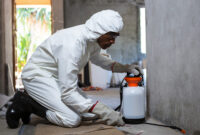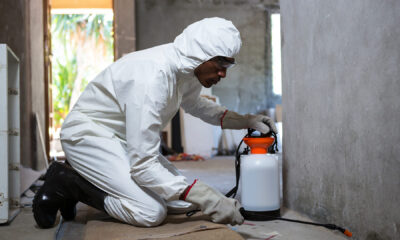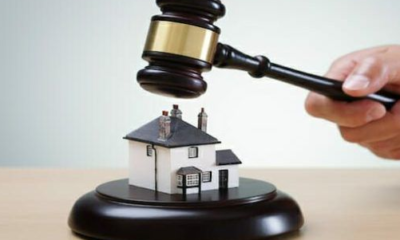Real Estate
Abrasive Blasting and Coating Services in Asset Rehabilitation Projects

Asset rehabilitation projects are fundamental to maintaining and extending the lifespan of Australia’s infrastructure. With a significant proportion of assets—including bridges, industrial facilities, pipelines, and public structures—aging faster than ever, it is essential to adopt best practices that ensure durability, safety, and cost-effectiveness. As a civil engineer working within this dynamic sector, I have seen firsthand how abrasive blasting and coating services can make a significant difference in the longevity and performance of rehabilitated assets. This article explores why these services are critical in asset rehabilitation projects across Australia, delving into the technical, environmental, and economic advantages they offer.
Understanding Asset Rehabilitation in Australia
Australia’s infrastructure portfolio is vast and diverse, spanning everything from remote rural roads to urban high-rise structures and critical industrial sites. Asset rehabilitation refers to the process of restoring, repairing, or upgrading existing infrastructure to extend its service life and ensure it meets current performance and safety standards. In a country characterised by harsh climates—from coastal corrosion due to salt spray to the temperature extremes of the outback—maintaining infrastructure is not only about aesthetics but also about ensuring public safety and operational reliability.
Abrasive Blasting: A Fundamental Surface Preparation Technique
Abrasive blasting is a mechanical process that removes contaminants, old coatings, rust, and other surface imperfections from substrates, leaving behind a clean and textured surface ready for new protective layers. In asset rehabilitation, achieving a properly prepared surface is the first and most critical step. There are several abrasive blasting techniques commonly used in Australia:
- Grit Blasting: This method uses abrasive media such as sand, aluminium oxide, or other specialized grit materials. The technique is particularly effective at removing corrosion products and old paint layers from metal surfaces.
- Shot Blasting: Utilizing steel shot or grit, shot blasting delivers high kinetic energy to the surface, removing heavy contaminants quickly. This method is often used for large-scale industrial assets where speed and efficiency are paramount.
- Wet Blasting: Combining water with abrasive media, wet blasting minimises dust emissions and is ideal for projects in densely populated areas or where environmental regulations require strict dust control.
The primary advantage of abrasive blasting lies in its ability to create a uniform profile on the substrate. This textured surface is essential for enhancing the mechanical bond between the substrate and the subsequent protective coating. Without a proper surface profile, even the highest quality coatings may fail prematurely due to poor adhesion. This is particularly critical in Australia, where environmental conditions can be unforgiving and accelerated corrosion is a constant threat.
The Importance of Coating Services in Asset Rehabilitation
Once the substrate has been meticulously prepared through abrasive blasting, the next step is to apply protective coatings. Coatings serve several vital functions in asset rehabilitation:
- Corrosion Protection: In coastal and industrial areas of Australia, exposure to saltwater, chemicals, and industrial pollutants accelerates the corrosion process. Protective coatings form a barrier between the substrate and these corrosive agents, significantly extending the service life of assets.
- Weather Resistance: Australia’s varied climate necessitates that coatings withstand a range of environmental stressors. From the intense ultraviolet (UV) radiation of the outback to the high humidity in tropical regions, coatings are engineered to maintain their integrity under diverse conditions.
- Chemical Resistance: Many Australian assets, particularly in the mining and chemical processing sectors, are exposed to aggressive chemicals. High-performance coatings offer resistance to chemical attack, ensuring that infrastructure remains safe and operational even under challenging conditions.
- Aesthetic Improvement: In addition to their protective qualities, coatings enhance the appearance of assets, providing a uniform and visually appealing finish. This is especially important for public structures, where appearance can be as significant as functionality.
Various types of coatings are available, including epoxy, polyurethane, and zinc-rich coatings. Each type is selected based on the specific demands of the asset, the environmental conditions, and the expected service life. Epoxy coatings, for example, are renowned for their durability and excellent adhesion properties, making them a popular choice for industrial applications. Polyurethane coatings, on the other hand, offer superior UV resistance and colour retention, making them ideal for outdoor applications.
The Synergy between Abrasive Blasting and Coating Services
The effectiveness of asset rehabilitation projects hinges on the seamless integration of abrasive blasting and coating services. While abrasive blasting prepares the substrate by removing contaminants and creating a profile conducive to adhesion, coating services provide the long-term protection needed to withstand environmental challenges. This synergy is critical for several reasons:
- Enhanced Adhesion: Abrasive blasting creates a micro-roughened surface that improves the mechanical bonding of the coating. This enhanced adhesion is crucial for ensuring that the coating remains intact over time, even under cyclic loading and environmental stress.
- Surface Uniformity: A clean, uniformly blasted surface minimises the risk of coating failure. Any residual contaminants or uneven surfaces can lead to blistering, peeling, or premature degradation of the coating. Uniform surface preparation guarantees that the coating performs as intended, thereby safeguarding the underlying asset.
- Extended Service Life: The combination of thorough surface preparation and high-quality coating significantly extends the asset’s lifespan. For civil engineers, this means reduced maintenance costs and fewer interruptions in service—a critical consideration for public infrastructure and industrial operations.
- Compliance with Standards: In Australia, asset rehabilitation projects must comply with strict standards and regulations. Both abrasive blasting and coating applications are subject to industry standards such as those set by Standards Australia. Ensuring that both processes are performed to a high standard is essential for regulatory compliance and for achieving long-term durability.
Environmental and Economic Considerations
Environmental and economic factors are two sides of the same coin in asset rehabilitation projects. Abrasive blasting and coating services, when executed properly, offer significant environmental and financial benefits.
Environmental Benefits
- Reduction in Waste: Proper surface preparation reduces the need for frequent re-coating and repairs, resulting in less waste over the asset’s lifecycle.
- Lower Emissions: Modern abrasive blasting techniques, such as wet blasting, minimise dust and particulate emissions. This is particularly essential in urban areas where air quality is a significant concern.
- Sustainable Materials: Many modern coatings are formulated to be environmentally friendly, using low-VOC (volatile organic compound) or even water-based formulations. These coatings help reduce the environmental impact of rehabilitation projects while maintaining high performance.
- Extended Asset Lifespan: By significantly extending the lifespan of assets, abrasive blasting and coating services contribute to sustainability. Extended service life means fewer resources are required for replacement or major repairs, which is a win for both the environment and project budgets.
Economic Benefits
- Cost-Effective Maintenance: While the initial investment in abrasive blasting and high-quality coatings may be higher than traditional methods, the long-term savings are considerable. Extended asset life and reduced maintenance frequency lead to significant cost savings over time.
- Minimised Downtime: For critical infrastructure, downtime can be extremely costly. By ensuring that protective coatings are properly applied and that assets are less prone to unexpected failures, rehabilitation projects help avoid costly service interruptions.
- Enhanced Asset Value: Properly rehabilitated assets not only perform better but also maintain their value over time. This is especially important for public infrastructure and industrial facilities, where asset value is a critical consideration for both operators and investors.
Australian Case Studies and Real-World Applications
Numerous asset rehabilitation projects across Australia have benefitted from the integration of abrasive blasting and coating services. For instance, many coastal bridges, which are constantly exposed to salt-laden air and harsh weather conditions, have seen dramatic improvements in longevity and performance following a rigorous rehabilitation programme. In these projects, abrasive blasting was employed to remove decades-old corrosion and contaminants, after which high-performance epoxy coatings were applied. The result was a significant reduction in maintenance requirements and a notable extension of the asset’s service life.
In another example, industrial facilities in Western Australia—where the mining industry plays a significant role—have adopted these techniques to protect critical machinery and infrastructure. The combination of abrasive blasting and specialised chemical-resistant coatings has helped mitigate the effects of chemical exposure and mechanical wear, thereby ensuring continuous operation and reducing the risk of costly shutdowns.
These case studies underscore the importance of adhering to best practices in asset rehabilitation. They demonstrate that a thorough understanding of both abrasive blasting and coating services, along with their proper execution, is essential for tackling the unique challenges posed by Australia’s diverse environmental conditions.
Technical Considerations and Industry Standards
For civil engineers, one of the most critical aspects of employing abrasive blasting and coating services is ensuring compliance with industry standards. In Australia, standards such as AS/NZS 2312 and AS 2692 provide guidelines for surface preparation and coating application. Adhering to these standards not only ensures the technical integrity of rehabilitation projects but also helps in managing risks associated with asset failure.
Key Technical Considerations Include:
- Surface Profile and Cleanliness: Achieving the correct surface profile is essential. Standards specify the required roughness and cleanliness levels, which in turn dictate the choice of abrasive media and blasting technique.
- Coating Thickness and Application Method: The performance of a coating is heavily dependent on its thickness and the method of application. Using the right equipment and techniques ensures that the coating adheres properly and performs as expected.
- Environmental Conditions: Factors such as humidity, temperature, and wind speed can influence both abrasive blasting and coating applications. Engineers must consider these conditions when planning and executing rehabilitation projects to avoid issues like premature curing or insufficient drying.
- Quality Assurance and Testing: Regular inspection and testing are critical components of any rehabilitation project. Quality control measures ensure that both the abrasive blasting and the coating application meet the prescribed standards, thereby safeguarding the asset’s performance over time.
Conclusion
Abrasive blasting and coating services are not merely optional enhancements in asset rehabilitation—they are critical components that ensure the longevity, safety, and cost-effectiveness of Australia’s infrastructure. Through effective surface preparation, abrasive blasting enables coatings to bond more securely, while high-performance coatings offer robust protection against the harsh environmental conditions that assets face every day.
In an environment as demanding as Australia’s, where infrastructure is continuously exposed to extremes of weather and corrosive agents, the synergy between these two services becomes paramount. The rigorous standards and proven techniques involved in abrasive blasting and coating applications ensure that rehabilitated assets meet modern performance requirements, minimise maintenance costs, and extend operational lifespans.
For civil engineers, the integration of abrasive blasting and coating services represents an essential strategy in asset rehabilitation projects. By investing in these critical processes, we not only safeguard our infrastructure but also contribute to sustainable practices and economic efficiency in the long term. As demonstrated by numerous projects across Australia—from coastal bridges to industrial facilities—the benefits of this approach are clear: enhanced adhesion, uniform surface treatment, compliance with industry standards, and ultimately, a more resilient and durable infrastructure.
Looking forward, as Australia continues to modernise its infrastructure, the role of abrasive blasting and coating services will only become more significant. The challenges of maintaining aging assets in a changing environment demand that we adopt innovative and robust rehabilitation methods. With a clear understanding of the technical, environmental, and economic advantages provided by these services, civil engineers are well-equipped to design and implement solutions that not only meet current needs but also pave the way for future advancements in asset rehabilitation.
In conclusion, whether it is preserving the structural integrity of a historic bridge or safeguarding the critical components of an industrial facility, abrasive blasting and coating services are indispensable in ensuring that our assets remain safe, durable, and cost-effective over their extended lifespans. As we face the future, these services will continue to be at the forefront of asset rehabilitation strategies, reinforcing our commitment to quality, sustainability, and engineering excellence in Australia.
Related posts:


Entertainment
KemonoParty: Where Creativity and Community Collide!

Entertainment
KemonoParty: Where Creativity and Community Collide!
Categories
- Apps (1)
- Automotive (23)
- Beauty (7)
- Business (122)
- Celebrities (2)
- Digital Marketing (21)
- Ecommerce (2)
- Education (21)
- Entertainment (39)
- Events (6)
- Fashion (1)
- Features (4)
- Finance (1)
- Fitness (10)
- Food (2)
- Forex & Crypto (22)
- General (116)
- Health (48)
- House (61)
- Lifestyle (57)
- Marketing (8)
- Parenting (3)
- Pets (10)
- Real Estate (8)
- Safety and Security (14)
- Social Media (31)
- Sports (134)
- Technology (73)
- Travel (23)


















